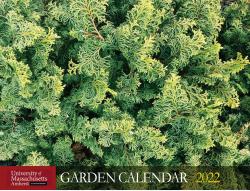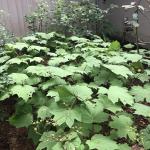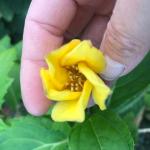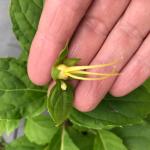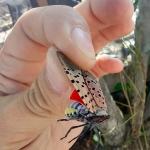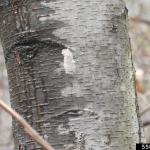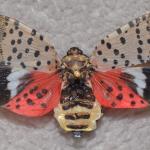A monthly e-newsletter from UMass Extension for landscapers, arborists, and other Green Industry professionals, including monthly tips for home gardeners.
To read individual sections of the message, click on the section headings below to expand the content:
A Message for Landscape Practitioners from the Be a Leaf Hero Campaign
 Get a fresh start this fall with better management of leaf litter. Here are three great approaches:
Get a fresh start this fall with better management of leaf litter. Here are three great approaches:
- Keep leaves off of driveways and roadways where they can easily wash into storm drains and contribute to higher nutrient flows during the fall season.
- Use a mulching mower. By mulching leaves into turf areas, you avoid having to rake/blow and bag and you offer a way to manage autumn leaves while providing clients with free fertilizer. Mulched leaves recycle nutrients and reduce the overall need for applied fertilizer, which can help to reduce nutrient loading for local rivers, streams, and lakes.
- Alternatively, if your client has an existing compost pile, you can recommend that they consider allowing you to add leaves to the pile. Leaves provide a critically important element (carbon) to the composting process, making for a more soil enriching product to be used in the next growing season. Be sure compost piles are located away from streams, lakes, or storm drains as these decomposing materials and nutrients could easily reach these water resources.
These three best practices are consistent with local efforts in many communities, under the Be a Leaf Hero campaign, to improve water quality in local rivers, streams, lakes, and coastal waters. Many lawn care practices can contribute to storm flows that are especially high in nutrients. Improper use and disposal of leaves, as well as grass clippings and fertilizers, can put nitrogen and phosphorous into storm runoff that enters local waters. These polluted flows promote the growth of algae and reduce dissolved oxygen, impacting recreational uses, such as swimming and fishing, and quality of habitat for wildlife.
Do your part and start anew with better land care practices this fall. For more information see: https://thinkblueconnecticutriver.org/be-a-leaf-hero/ and https://ag.umass.edu/landscape/fact-sheets/yard-waste-management-in-massachusetts
From the municipalities collaborating on Think Blue Connecticut River and Think Blue Massachusetts.
2022 UMass Garden Calendar
While gardeners don’t always think of hungry caterpillars as desirable, robust caterpillar populations are important food resources that support bird populations. Researchers suggest the top 5 most important plant genera that support caterpillar populations, which in turn helps feed the birds. As a gardener or land steward, choosing to plant one of these native tree species may have the largest impact on supporting caterpillar populations.
UMass Extension works with the citizens of Massachusetts to help them make sound choices about growing, planting, and maintaining plants in our landscapes, including vegetables, backyard fruits, and ornamental plants. Our 2022 calendar continues UMass Extension’s tradition of providing gardeners with useful and practical information. Many people also love the daily tips and find the daily sunrise/sunset times highly useful!
Show your clients you appreciate their business this year! Special pricing is available on orders of 10 copies or more.
COST: $14; shipping is FREE on orders of 9 or fewer calendars - FREE SHIPPING ENDS NOV 1!
FOR IMAGES IN THE CALENDAR, details, and ordering info, go to umassgardencalendar.org.
As always, each month features:
- An inspiring garden image.
- Daily gardening tips for Northeast growing conditions.
- Daily sunrise and sunset times.
- Phases of the moon.
- Plenty of room for notes.
- Low gloss paper for easy writing.
Hot Topics
It’s Fall and the Brown Marmorated Stink Bug May Try to Get in Your Home
For the Brown Marmorated Stink Bug (BMSB), fall means looking for overwintering sites. This invasive stink bug is a significant agricultural pest of non-native origin. In addition to causing damage to many types of plants and fruit in the summer and early fall, BMSB becomes a nuisance pest both indoors and out when it is attracted to the outside of houses on warm fall days in search of protected overwintering sites.
High numbers of BMSB result from the release of an aggregation pheromone (a scent that attracts other BMSB to the area). The aggregation pheromone is not the same chemical that causes them to stink. During the winter months, BMSB enters a type of hibernation called diapause. During this time they do not feed and do not reproduce. The BMSB is the only stink bug known to congregate inside houses and other buildings in the fall.
The Brown Marmorated Stink Bug is not harmful to people, houses, or pets. They do not bite, sting, suck blood, or spread diseases; and they do not eat or bore into wood structures. However, adults emit an offensive odor if disturbed or crushed.
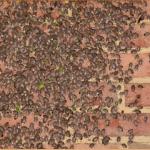 Mechanical exclusion is the best method to keep BMSB from entering homes and buildings. This also applies to the Multicolored Asian Lady Beetle, another insect species that is known to congregate in and around homes and buildings in the fall. Placement of screens over windows, doors and vents; removal of window air conditioners; and caulking cracks in windows and doorframes will deter the adults from entering. Removal of window air conditioners is important, as numerous BMSB will enter this way. Insecticide foggers or sprays are not recommended for eliminating BMSB indoors. Both live and dead BMSB can be removed from interior areas with the aid of a vacuum cleaner - however, the vacuum may acquire the smell of stink bugs for a period of time.
Mechanical exclusion is the best method to keep BMSB from entering homes and buildings. This also applies to the Multicolored Asian Lady Beetle, another insect species that is known to congregate in and around homes and buildings in the fall. Placement of screens over windows, doors and vents; removal of window air conditioners; and caulking cracks in windows and doorframes will deter the adults from entering. Removal of window air conditioners is important, as numerous BMSB will enter this way. Insecticide foggers or sprays are not recommended for eliminating BMSB indoors. Both live and dead BMSB can be removed from interior areas with the aid of a vacuum cleaner - however, the vacuum may acquire the smell of stink bugs for a period of time.
You'll likely see BMSB adults congregating on brick surfaces on warm, autumn days, attempting to absorb some of the heat. They're also looking for a way to get inside.
This 30-second video shows how to construct a simple light trap to kill BMSB inside your home.
Dr. Jaime Piñero, Stockbridge School of Agriculture and UMass Extension
Featured Plant
Yellow waxbells (Kirengeshoma palmata)
Imagine my delight as I stepped into a client’s garden recently, expecting to find the ubiquitous hostas and astilbes, but instead coming face-to-face with a plant I didn’t know: a shrubby, dark green specimen with maplelike leaves and dangling, lemon-hued, bell-shaped flowers. What was this intriguing plant? Fortunately, I stumbled upon a single container of it at my local garden center the following week and snapped it up as soon as I saw it. The name on the tag? Yellow waxbells, or Kirengeshoma palmata.
A member of the hydrangea family, yellow waxbells is an herbaceous perennial that assumes an almost shrubby habit as it grows. The plant can reach a size of 3 to 4 or 4½ feet in height by 2 to 3 feet in width. Its stiff stems and leaf petioles are tinged purple, and for much of the growing season, waxbells main ornamental features are these colorful stalks and the large (up to 8 inches across) fuzzy leaves so reminiscent of maple—at first glance, I thought the plant was some type of flowering maple (Abutilon spp.), so pronounced was the foliage resemblance. Fortunately, waxbells is much hardier than flowering maple; it is native to mountainous regions of Japan and Korea. (The slightly larger version found in Korea is classified as either a separate species or a subspecies of Kirengeshoma palmata: K. koreana or K. palmata Koreana Group.) Various references rate waxbells as hardy in zones 4 or 5 to 7 or 8, and it performs well in zone 5b in the Berkshires.
Flowering occurs on yellow waxbells from late summer to mid fall. Flower buds emerge round and marble-sized either singly or in loose clusters in the uppermost leaf axils. As they develop, blossoms elongate into 1½ inch bell shapes before opening, downward facing and with 5 whorled, fleshy petals. The clear yellow hue of the flowers is lovely but somewhat fleeting, as bells begin to develop brown edges after a few days. However, the show continues after flowering with what one horticultural expert calls “the ‘Stephen King’ of fruit” (Armitage, 1997): round capsules with 3 protruding horns.
A search through the literature suggests yellow waxbells are a bit particular when it comes to growing conditions. Waxbells will grow well in part to full shade (flowers are more numerous with some sun) and it prefers soil that is both slightly acidic as well as rich in organic matter. Moisture level around the plant’s roots should be kept consistent, especially during dry periods. And waxbells benefits from siting in a location protected from battering winds. Beyond these requirements, waxbells is relatively trouble-free: it has no serious pest or disease problems outside of the occasional snail or slug hole in young leaves, and while the plant does grow from rhizomes, it is certainly not considered invasive. According to University of Wisconsin Extension, waxbells is “best propagated by division just as growth begins in the spring, separating the crowns of large clumps so that there are at least three buds in each portion. It can also be grown from seed, which should be sown as soon as it is ripe (although they may not germinate until spring), or from cuttings taken in early summer.” (Mahr, n.d.)
Given its attractive appearance throughout the growing season, yellow waxbells complements shade-loving plants with finer foliage, such as ferns and astilbe or plants with contrasting foliage color, such as purple-leaved ‘Chocolate’ eupatorium (Eupatorium rugosum) or ‘Brunette’ bugbane (Actaea simplex); golden-toned ‘Citronelle’ or ‘Twist of Lime’ coral bells (Heuchera spp.) or ‘Aureola’ Japanese forest grass (Hakonechloa macra); and variegated hostas or ‘Ice Dance’ sedge (Carex sp.).
References:
Armitage, Allan. (1997). Herbaceous perennial plants: A treatise on their identification, culture, and garden attributes. Champaign, IL: Stipes Publishing, LLC.
Kirengeshoma palmata (n.d.). Missouri Botanical Garden Plant Finder. http://www.missouribotanicalgarden.org/PlantFinder/PlantFinderSearch.aspx
Mahr, Susan. (n.d.). Yellow wax bells, Kirengeshoma palmata. Wisconsin Horticulture Division of Extension Articles. https://hort.extension.wisc.edu/articles/yellow-wax-bells-kirengeshoma-palmata/
Jennifer Kujawski, Horticulturist
Trouble Maker of the Month
The Spotted Lanternfly Arrives in Massachusetts
The MA Department of Agricultural Resources (MDAR) announced on September 28, 2021 that a small, established, and breeding population of the invasive spotted lanternfly (Lycorma delicatula) was detected in Worcester County, MA in the city of Fitchburg. This finding was confirmed by state officials.
For further details regarding what is known about the population in Fitchburg, MA and MDAR’s response, visit this press release.
What Should You Do?
Residents and professionals living and working across the Commonwealth should learn the life stages of the spotted lanternfly and be able to identify their eggs, immatures, and adults. At this time, it is particularly valuable to learn how to ID spotted lanternfly adults and egg masses. If any life stages of this insect are found in Massachusetts, report them immediately here. Adults may be seen until after the first couple of hard frosts. Egg masses may be seen overwintering on just about any flat surface, including but not limited to: host plants, firewood, live plants for sale, fences, stone, outdoor furniture and structures, vehicles, and much more.
In particular, if you know of tree of heaven (Ailanthus altissima)1 growing nearby, check that preferred host for adults and egg masses and report anything suspicious to the aforementioned website. That said, spotted lanternfly adults and eggs masses (and immatures when active) may be found just about anywhere. (Other preferred hosts include grape vines, maple, and walnut trees.)
Should You Treat?
At this time, the only established (breeding) population of spotted lanternfly in Massachusetts is in a small area of Fitchburg, MA. Therefore, there is no reason to be preemptively treating for this insect in other areas of Massachusetts at the time this article was written. If you suspect you have found spotted lanternfly in additional locations, please report it immediately to MDAR at the link provided above. If you are living and working in the Fitchburg area, please be vigilant and continue to report anything suspicious.
What is at Risk?
The spotted lanternfly feeds on over 103 different species of plants, including agriculturally significant crops (apple, peach, grape, etc.) and trees and shrubs that are important in our managed landscapes and natural areas. Due to various factors, spotted lanternflies are also a significant public nuisance once they become established.
1The tree of heaven is a rapidly growing deciduous tree native to China and Taiwan that has become a widespread invasive species across North America. Learn how to identify this invasive tree here.
For More Information
- From UMass Extension
- From the MA Department of Agricultural Resources
- Spotted Lanternfly fact sheet
- Best Management Practices for Nurseries and Landscapers (January 2021)
- Best Practices for Businesses
- Checklist for Residents in or near Infested Areas
- Driver’s Checklist in English or Spanish (September 2021)
- Moving Industry Checklist (February 2021)
Tawny Simisky, Extension Entomologist, UMass Extension Landscape, Nursery, & Urban Forestry Program
Q&A
Q: What can I do to protect two- and three-needle pines from Diplodia blight?
A: Diplodia blight of two- and three-needle pines, caused by Diplodia sapinea, has been abundant this growing season. The disease primarily occurs on Scots (Pinus sylvestris), red (P. resinosa), mugo (P. mugo) and Austrian (P. nigra) pines. However, the pathogen has a very broad host range among the Pineaceae and can also attack five-needle pines (e.g. P. strobus, P. flexis and P. koraiensis), false-cypress (Chamaecyparis), spruce (Picea), true cedar (Cedrus), among other landscape conifers. Diplodia sapinea has even been found on oaks (Quercus), illustrating its dynamic nature. Symptoms of Diplodia blight appear as shoot tip blight in early summer, and browning needles/scattered dieback throughout the canopy during the summer. Infected needles often turn from brown to grey over the growing season. Drought stress from 2020 likely predisposed many landscape pines to infection, despite their natural drought resistance.
Many two- and three-needle pines are adapted to dry and nutrient poor sites. By maintaining a naturally sparse canopy, these trees avoid the conditions that allow needle and stem blight pathogens to proliferate. Specifically, many conifer pathogens thrive within lower and interior portions of the canopy where dense branching and heavy shade allow moisture to linger. However, many dwarf and intermediate cultivars of two- and three-needle pines have very dense, mounded canopies that create ideal conditions for the disease (i.e. P. resinosa ‘Morel’). These forms can create major problems should Diplodia blight establish.
If Diplodia blight is a concern or has been present in the past, consider pruning to improve sunlight penetration, increase air flow and accelerate drying through the canopy. This is especially true of lower canopy branches, especially if they receive little to no direct sunlight. Maintain a thick mulch layer around the base of the plants, remove underlying or surrounding plantings that cast shade, and provide supplemental irrigation during extended dry periods to manage drought stress. Care should be taken when fertilizing two- and three-needle pines with nitrogen. An abundance of succulent tissues in the spring can allow Diplodia blight to rapidly intensity when the pathogen is present.
Early detection is important when managing Diplodia blight. Carefully scout as new candles and needles are elongating. When Diplodia blight is present, the needles at the shoot tips will typically die when they are 1/3 to 1/2 elongated. Immediate pruning and removal of this diseased tissue when it appears can keep the infection from spreading throughout the canopy. Locally-systemic fungicides, such as azoxystrobin and thiophanate-methyl, when applied to the new growth can be helpful in keeping these new sensitive tissues protected. Systemic fungicides with a single mode of action should be rotated to avoid resistance development. Broad-spectrum protectants, such as copper hydroxide, metconaozle and mancozeb are effective chemicals as well.
For more information, see this UMass Extension fact sheet: https://ag.umass.edu/landscape/fact-sheets/diplodia-blight
Nicholas J. Brazee, UMass Extenstion Plant Pathologist
Garden Clippings Tips of the Month
October is the month to . . . .
- Test your soil. October is the perfect time to test your soil and make pH adjustments such as adding limestone. Make sure to follow the proper instructions for taking soil samples. Soil test recommendations are only as good as the sample submitted. See the UMass Soil and Plant Nutrient Testing Laboratory web site for more info on how to submit a sample for testing, fees, and info on how to take a sample.
- Plant garlic. Garlic should be planted shortly after the first frost and before regular hard freezes (25-28oF), which is typically in October or early November. Plant only the largest cloves, since larger cloves produce larger bulbs, and plant about finger deep. There are two types of garlic: hardneck and softneck. Hardneck garlic produces a scape, often has purple color in the paper covering of the head, and produces fewer larger cloves per bulb. Softneck garlic typically produce more cloves, stores longer and is easier to braid.
- Keep leaves from accumulating on the lawn. Autumn is an important time for growth of cool season turfgrasses. Photosynthesis that occurs now helps build robust root systems and increases stored carbohydrates, leading to a healthy lawn in spring. Accumulating leaves can be mulch mown and left on the lawn or removed.
- Don’t throw away leaves. Fallen leaves gathered from raking, mowing, or blowing are a great organic matter resource. Instead of hauling the leaves away, use as a mulch. Chopped or mown leaves are less susceptible to blowing around and have a similar look to bark mulch. Unshredded leaves tend to mat together and can impede water and air infiltration. Mulched leaves break down fairly quickly, increasing soil organic matter.
- Decide whether flower bed cleanup is necessary now or later. In many gardens, seed heads and spent flowers can be left as a resource for wildlife, especially birds. Leave the seed heads and spent flowers until after the seeds have been eaten or until spring cleanup. Spent stems can also provide important overwintering sites for pollinators. However, gardens that have disease pressure from leaf spots, blights, and rusts should be cleaned up now. Since these diseases often overwinter on plant debris, diligent fall cleanup can greatly reduce inoculum for next year.
- Plant spring flowering bulbs. Crocuses, daffodils, hyacinths, squills and tulips should all be planted as the soil begins to cool. To get the best display from spring flowering bulbs, plant en masse (hundreds) instead of just planting a couple here and there.
- Dig summer bulbs. Cannas, dahlias, elephant ears, gladiolus, and tuberous begonias should all be dug after the foliage receives a light frost. Dig bulbs on a dry day and instead of washing, let air dry and then lightly brush off the soil. Store in peat moss or sawdust in a location that is cool, dry and dark.
- Complete dividing and planting projects. Columbus Day is a good target for completing projects such as dividing spring blooming perennials or planting deciduous woody ornamentals. Planting at this time allows for some root growth to occur before growth ceases for the season.
Russ Norton, Agriculture & Horticulture Extension Educator, Cape Cod Cooperative Extension
Exploring Volunteer Urban Tree Committees in Massachusetts (Part 2)
Part 1 of this article appeared in the September issue of Hort Notes (Vol 32:7).
In part I of this article, the authors introduced the exploration of volunteer urban tree committees in Massachusetts, discussing their operational characteristics. Here they continue with the final segment – a discussion about the community and organizational relationships closely associated with these committees.
3. Community Relationships
Tree committee representatives reported that they often interacted with a variety of important and successful collaborators including the municipal ‘DPW’ (n=6), and ‘town committees, commissions’ (n=6) and a variety of NGO’s (n=8), (i.e., ‘garden clubs’ and ‘environmental groups’).
Overall, the interview data revealed that nearly all of the urban tree committees identified ‘unsuccessful collaborators’ (n=12), however, clear specifics were less emergent.
Evaluation of urban tree committee programs generated some interesting responses from interviewees, and while a clear theme emerged relative to the fact that ‘no’ (n=6) members often did not perform a formal program evaluation, ‘informal’ (n=9) discussion-based evaluation of committee-based initiatives did occur:
“…there’s no formal means of evaluating. I mean, because we meet every month, within the committee we evaluate projects as they’re going and certainly feedback from the tree warden and the director of the DPW. I would say there’s certainly not a lack of resident feedback when we…do something…not formal but a monthly check-in, certainly.” (Arlington Tree Committee)
The manners in which urban tree committees carried out public interaction included ‘in-person interaction’ (n=7) (i.e., at a table or booth), or through ‘print media’ (n=6) or ‘electronic, social media’ (n=11). They also indicated that they felt there was an ongoing ‘need for volunteers’ (n=4) and that they attempted to ‘foster camaraderie & interest’ (n=5) to maintain the volunteers they have.
In describing the relationship with the community tree warden, urban tree committees reported that they generally had a ‘positive relationship’ (n=7) and that there was ‘regular communication’ (n=6) between the two parties.
“…if any of us have a question, we either email or call him [the tree warden] and he’s incredibly responsive and always able to give us an update…” (Brookline Tree Planting Committee)
“We love him. He’s awesome. Engineer from – spent ten years in Cambridge…good guidance there. He has a great attitude…so the relationship has been super positive from day one.” (Newburyport Tree Committee)
“I recruited a fellow – another landscaper to become tree warden whom I worked with previously, so he’s now in that position. So, we have a good relationship and we discuss all aspects and all work.” (Marion Tree Committee)
Three other committee’s indicated they had ‘limited interaction’ with their local tree warden and that they were “uncertain” as to the state of their relationship. Interviewees typically described the relationship between themselves and community decision makers as being ‘positive’ (n=10). A prominent number (n=8) of urban forest tree committees reported ‘yes’ they were actively involved in policy development relating to ‘local tree by-laws’ and ‘local tree ordinances’.
Observations
That there were a variety of important and successful collaborators identified by interviewees was not a surprise; what was interesting though, was that responses were less specific regarding unsuccessful collaborators. According to the Lanesborough tree & forest committee, the fact that a volunteer urban forest tree committee plays a very specific role in the community may simply decrease the chances of an unsuccessful collaboration:
“You know, I guess our span of interest is narrow enough that I don’t know that I would say there were any unsuccessful collaborations. I’m not trying to say we do everything right. I guess I’m trying to say we haven’t pushed the envelope too far.”
It is also possible that interviewees consider the divulgence of an unsuccessful collaboration somewhat sensitive, and individuals generally may not be as forthcoming with this sort of information in a research environment (Cartwright, 1988).
The fact that so many (n=11) urban forest tree committees indicated they employed some form of ‘electronic, social media’ to interact with the public was of interest. Upon further exploration of this theme, however, a prominent number of interviewees indicated this method is through ‘Facebook’, and nearly all sources indicated this form of interaction is through a website typically housed by the municipality. In fact, some individuals highlighted the need to engage their community by increasing their urban forest tree committee’s capacity in the realm of social media:
“…we’re working – starting to work with social media. We have a Facebook page and a website. And we have a new woman who just joined the committee who is younger and much more cognizant of social media than I am and she’s going to take that sort of thing on…” (Amherst Public Shade Tree Committee)
“We don’t do a website because we don’t have anyone young enough right now to be that savvy. And I am not a web person. That’d be a good reminder that the world does not travel on paper anymore. It travels on websites and Facebook ‘likes’ and we have to figure out how to do that (Lanesborough Tree & Forest Committee)
The fact that the ongoing ‘need for volunteers’ (n=4) was an emergent theme may be concerning for individuals who find themselves on the front lines of volunteering in any sector, including on urban forest tree committees. Across the U.S. and in other developed nations, membership in civic organizations and volunteerism in specific sectors, as well as generally, appears to be on a downward trajectory (Putnam, 1996; Green and Haines, 2016). Just as volunteerism itself has positive ramifications that extend beyond the individual and impact the economy and viability of organizations, a shrinking volunteer base may impact – and be indicative of – a range of segments of society from graduation rates, to participation in the democratic process (Green and Haines, 2016).
Most committees enthusiastically indicated that they had a positive relationship (n=7) their local tree warden, yet not all committees (n=3) felt this way. Though details about the workings of this relationship are largely absent from the research literature, according to Harper et al. (2017), the nature of the position of a successful tree warden requires effective communication and interaction with a wide number of groups, including urban forest tree committees. Though Fazio (2015) does not mention tree wardens by name, he does posit that tree boards must work closely with city foresters. For an effective urban forest tree committee, it is critical that this same sentiment of cooperation and partnership can be readily extended to other audiences and important stakeholders including local officials, agencies and organizations.
Conclusions
Volunteer involvement in urban forestry, including service on an urban forest tree committee, may help to provide essential experience, new ideas and perspectives and offer critical skills towards the furtherance of urban tree management at the local level (Westphal and Childs, 1994). Volunteers may also enable access to new audiences and advocates through networks and contacts (Nichnadowicz, 2000). Urban foresters routinely identify a lack of available resources (i.e., funding) as a key limiting factor (Stobbart and Johnston, 2012) in their urban forest management program, hence the potentially-reduced costs associated with garnering volunteer-based support to aid or carry out initiatives, may also be another welcomed benefit in relation to volunteer involvement in urban forestry (Bloniarz and Ryan, 1996; M. Welch, pers. comm.). Though typically not paid, volunteers and volunteer-based initiatives do require investment, however, including in equipment, training, and care (i.e., food and water, first aid and safety equipment) (Fazio, 2015). Volunteer-related expenditures might also include small-scale celebrations after a significant task is carried out (i.e., a larger-scale urban tree planting or urban tree inventory), like an appreciation dinner. This may bolster morale, and if volunteers know they are valued and feel their efforts are acknowledged, they can connect more fully with the organization and each other, resulting in an increased sense of belonging and involvement (Moran and Mallia, 2015). This can act as a positive “loop” since increased involvement can motivate volunteers to continue their relationship and deepen their service commitment with the association (Lammers, 1991; Moran & Mallia, 2015). Another means of strengthening the effectiveness of urban forest tree committees could be to provide members with formal program evaluation materials and training so that program delivery may continually be improved and strengthened.
Urban forest tree committee volunteers in Massachusetts are typically passionate, committed individuals who love trees and wish to see this important urban resource managed with care and stewardship in mind. Lipkis and Lipkis (1990) summarize these sentiments in stating,
“Tree planting…fosters community spirit and pride, bringing people together for a meaningful purpose that can build the bridges and promote the understanding that brings the neighborhood together. The initial efforts of the tree planters compound themselves as others find in the trees a deeper appreciation of the community as well as natural beauty.” (p. viii)
To ensure viability in this sector of volunteerism, committee members could be equipped with resources related to the use of social media as well as strategies to engage and broaden the base of individuals potentially willing to serve on their urban forest tree committee. Successful volunteers serving on an urban forest tree committee would benefit from having the ability to work constructively and cooperatively with a wide number of stakeholders, decision makers and audience members, with special attention being given to the community tree warden. Since this individual is pivotal to the urban forest operations in a given municipality (Harper et al., 2017), urban forest tree committee members in Massachusetts – and other states with this position – can make a concerted, sustained effort to foster a cooperative, productive relationship with their tree warden. Also, since many urban forest tree committees are actively involved in local policy formation (i.e., tree ordinances, by-laws), research could further explore the need and efficacy of legal training for committee volunteers. These, and other important topics, are worthy of continued examination as we strive to better understand the nature of volunteer-led urban forest tree committees.
Literature Cited
Bloniarz, D.V., Ryan, H.D.P., 1996. The use of volunteer initiatives in conducting urban forest resource inventories. Jour. Arboricult. 22, 75-82.
Cartwright, A. 1988. Interview or postal questionnaires? Comparisons of data about women’s experiences with maternity services. The Milbank Quart. 66, 172-189.
Fazio, J.R., 2015. Tree board handbook. Arbor Day Foundation. Lincoln, NE.
Green G.P., Haines, A., 2016. Asset building and community development, 4th ed., Sage Publications, Inc., Thousand Oaks, CA.
Harper, R.W., Bloniarz, D.V., DeStefano, S., Nicolson, C.R., 2017. Urban forest management in New England: Towards a contemporary understanding of tree wardens in Massachusetts communities, Arboricult. Jour. 39, 1-17.
Harper, R.W., Bloniarz, D.V., DeStefano, S., Nicolson, C.R., 2018. Exploring the characteristics of successful volunteer-led urban forest tree committees in Massachusetts. Urban Forestry & Urban Greening 34: 311-317.
Harrison, V.S., Xiao, A., Ott, H.K., Bortree, D., 2017. Calling all volunteers: The role of stewardship and involvement in volunteer-organization relationships. Public Rel. Rev. 43, 872-881.
Johnston, M., 2015. Trees in towns and cities: A history of British urban arboriculture. Oxford: Oxbow Books.
Lammers, J.C., 1991. Attitudes, motives and demographic predictors of volunteer commitment and service duration. Journal of Social Service Research, 14, 125- 140.
Lipkis, A., Lipkis, K., 1990. The simple act of planting a tree: A citizen foresters guide to healing your neighbourhood, your city, and your world. Tree People, Los Angeles, CA. 236 pp.
Moran, K., Mallia, T., 2015. Wholly engaged: Integrating volunteer and donor programs. In R. J. Rosenthal (Ed.), Volunteer engagement 2.0: Ideas and insights changing the world. Hoboken, NJ: John Wiley & Sons.
Nichnadowicz, J., 2000. Community involvement in urban forestry programs. In J.E. Kuser (Ed.), Handbook of urban and community forestry in the Northeast. New York, NY: Kluwer Academic/Plenum.
Putnam, R., 1996. The strange disappearance of civic America. Policy: A Jour. of Public Policy and Ideas. 12, 3-15.
Stobbart, M., Johnston, M., 2012. A survey of urban tree management in New Zealand. Arboricult. Urban For. 38, 247 – 254.
Westphal L.M., Childs G., 1994. Overcoming obstacles creating volunteer partnerships. J. Arboricult. 92, 28-32.
Acknowledgments
We thank the following individuals and organizations: M. Davidsohn, UMass Dept. of Landscape Architecture & Regional Planning; UMass Dept. of Environmental Conservation; and the UMass Center for Agriculture, Food & Environment. This initiative was funded in part by the USDA Forest Service through the Massachusetts Department of Conservation and Recreation Urban & Community Forestry Program. Any use of trade, firm, or product names is for descriptive purposes only and does not imply endorsement by the U.S. Government.
Richard W. Harper, Extension Associate Professor of Urban & Community Forestry, UMass Amherst; Emily S. Huff, Ph.D., Assistant Professor of Human Dimensions in Natural Resources, Michigan State University; David V. Bloniarz, Ph.D., Director USDA Forest Service Urban Natural Resources Institute; Stephen DeStefano, Director of the Mass. Cooperative Fish & Wildlife Research Unit – U.S. Geological Survey; and Craig R. Nicolson, Ph.D., Lecturer of Sustainability Science, UMass Amherst
Upcoming Events
For more details and registration options for any of these events, go to the UMass Extension Landscape, Nursery, and Urban Forestry Program Upcoming Events Page.
-
Invasive Insect Certification Program - a series of 6 webinars, 9:00 AM – 12:00 PM
These webinars will not be recorded for later viewing.
Credits: 2 pesticide credits for categories 29, 35, 36, 48 and Applicators License available for EACH webinar.-
Day 5: Tue, Oct 26: Management of Invasive Forest and Landscape Insect Pests
-
Day 6: Wed, Oct 27: Management of Invasive Forest and Landscape Insect Pests, continued
-
- Nov 17 - Fall Wrap-Up: Woody Ornamental topics - live via GoToWebinar. Detalis coming soon at https://ag.umass.edu/landscape/upcoming-events
- Nov 18 - Fall Wrap-Up: Turf topics - live via GoToWebinar. Detalis coming soon at https://ag.umass.edu/landscape/upcoming-events
Pesticide Exam Preparation and Recertification Courses
These workshops are currently being offered online. Contact Natalia Clifton at nclifton@umass.edu or go to https://www.umass.edu/pested for more info.
InsectXaminer!
Episodes so far featuring gypsy moth, lily leaf beetle, euonymus caterpillar, and imported willow leaf beetle can be found at: https://ag.umass.edu/landscape/education-events/insectxaminer
TickTalk with TickReport Webinars
To view recordings of past webinars in this series, go to: https://ag.umass.edu/landscape/education-events/ticktalk-with-tickreport-webinars
Additional Resources
For detailed reports on growing conditions and pest activity – Check out the Landscape Message
For professional turf managers - Check out our Turf Management Updates
For commercial growers of greenhouse crops and flowers - Check out the New England Greenhouse Update website
For home gardeners and garden retailers - Check out our home lawn and garden resources.
Diagnostic Services
Landscape and Turf Problem Diagnostics - The UMass Plant Diagnostic Lab is accepting plant disease, insect pest and invasive plant/weed samples . By mail is preferred, but clients who would like to hand-deliver samples may do so by leaving them in the bin marked "Diagnostic Lab Samples" near the back door of French Hall (please note that visitors are not allowed inside the building). The lab serves commercial landscape contractors, turf managers, arborists, nurseries and other green industry professionals. It provides woody plant and turf disease analysis, woody plant and turf insect identification, turfgrass identification, weed identification, and offers a report of pest management strategies that are research based, economically sound and environmentally appropriate for the situation. Accurate diagnosis for a turf or landscape problem can often eliminate or reduce the need for pesticide use. See our website for instructions on sample submission and for a sample submission form at https://ag.umass.edu/services/plant-diagnostics-laboratory. Mail delivery services and staffing have been altered due to the pandemic, so please allow for some additional time for samples to arrive at the lab and undergo the diagnostic process.
Soil and Plant Nutrient Testing - The lab is currently accepting new orders for Routine Soil Analysis (including optional Organic Matter, Soluble Salts, and Nitrate testing), Particle Size Analysis, Pre-Sidedress Nitrate (PSNT), and Soilless Media (no other types of soil analyses available at this time). Testing services are available to all. Send orders via USPS, UPS, FedEx or other private carrier (hand delivered orders cannot be accepted at this time). Please plan for the fact that date of receipt in the lab is affected by weekends, holidays, shipping time, and time for UMass Campus Mail to deliver samples to the lab. The lab provides test results and recommendations that lead to the wise and economical use of soils and soil amendments. For updates and order forms, visit the UMass Soil and Plant Nutrient Testing Laboratory web site.
Tick Testing - The UMass Center for Agriculture, Food, and the Environment provides a list of potential tick identification and testing options at: https://ag.umass.edu/resources/tick-testing-resources.
